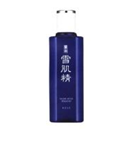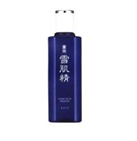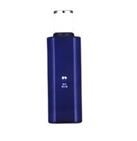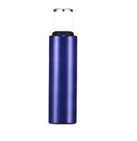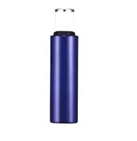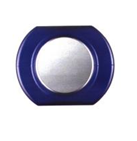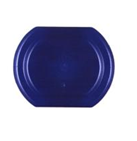I. Facts
The Appellee (the Applicant), KOSE CORPORATION, filed a trademark application with the Appellant, the Taiwan Intellectual Property Office (TIPO), for the three-dimensional trademark “雪肌精(3D MARK)” on December 27, 2011 for use on goods “cosmetics; perfumes; eau de cologne; milks [cosmetics]; non-medicated nutritional creams; foundation make-up; pressed face powder; lipsticks; eyeliner pencils; eye shadow; eyebrow pencils; nail polish; toilet water; blushers; soaps for body care; toilet soap; hair protection creams; hair conditioners; shampoos; hair care preparations; bath preparations, bath oils, bath salts” in Class 3.
When examining this case, the TIPO decided that the three-dimensional shape and color of the bottle device of the subject mark are commonly used by businesses of the same trade, so the subject mark for use on the foregoing goods is indistinctive and could give rise to doubts as to the scope of the trademark rights, and that the Applicant at that time did not enter the disclaimers, so based on Article 29-III of the Trademark Act in force at that time, the registration of the subject mark was not approved. The Applicant was not satisfied with the Rejection Decision issued by the TIPO and filed an Administrative Appeal, which was rejected, and the Applicant subsequently filed an Administrative Suit with the Intellectual Property Court (IP Court). The IP Court made a Judgment overturning the Administrative Appeal and Rejection Decision and ordered the TIPO to make a new decision in line with the legal opinions in the Judgment for trademark Appl. No. 100066697 “雪肌精 (3D MARK).” The TIPO filed an Appeal against the Judgment.
II. Issues
1. Whether the subject mark is inherently distinctive.
2. Whether the subject mark has acquired distinctiveness.
3. Whether the “Evaluation Main Points on The Market Survey Report Provided by A Concerned Party” published by the Fair Trade Commission can be applied to the market survey report submitted by the Appellee.
III. Summary of the Supreme Administrative Court Judgment
1. In terms of inherent distinctiveness:
(1) Concerning the three-dimensional shape and colors of the bottle device of the subject mark, the IP Court held that: the front and back sides thereof are flat, and the left and right sides thereof are elliptical; there are four upright linear tapers which form respective intersections between the end faces of the front, left and right and back sides, and a white bottle cap with a silver mirror top; the bottle is translucent blue glass combined with white and silver colors, which convey a beautiful visual impression. Even if the appearance of the bottle conveys a special impression to consumers, it is merely a decorative container, which can hardly serve as identification from other’s goods.
(2) Further, the IP Court held that: “The design concept of the subject mark “雪肌精 (Snow white skin extracts)” is derived from the image of snow, and the snow-white bottle cap with its silver-mirrored top surface adds the appearance of snow; the translucent blue bottle has a sapphire-like appearance. The white characters on the bottle correspond to the images of individual snowflakes. The overall three-dimensional shape and color of the subject mark depict a night-blue sky, a snow-covered landscape, and a bright full moon. Although the subject mark corresponds to the design concept of the registered mark “雪肌精”, from the point of view of relevant consumers, the subject mark is generally deemed as a decorative design, instead of an identification of the source of goods. As for the bottle with the polygonal configuration and smooth edges, it is a product package generally used by relevant businesses in the same field; the three-dimensional shape and color of the bottle device of the subject mark are similar to the packages of other businesses. The impression conveyed by the subject mark to relevant consumers is merely a product package, instead of being an identification of source of goods, so it is not inherently distinctive.”
2. In terms of acquired distinctiveness:
(1) Article 29-II of the Trademark Act provides that “Subparagraph 1 or 3 of 29-I shall not apply if the trademark has been used by the applicant and has become, in trade, a sign capable of distinguishing the goods or services of the applicant.” Articles 29-I-1 and 29-I-3 refer to the trademark consisting exclusively of a description of the quality, intended purpose, material, place of origin, or relevant characteristics of the designated goods or services; or consisting exclusively of other signs which are devoid of any distinctiveness. Accordingly, only trademarks without inherent distinctiveness can be registered on items with acquired distinctiveness if said trademark has been used by the applicant and has become a sign indicating the source of goods or services. The premise of acquired distinctiveness is that a trademark has no inherent distinctiveness. If a trademark is inherently distinctive, there is no need to discuss acquired distinctiveness. Regarding the combination of the three-dimensional shape and color of the bottle device of the subject mark, since the IP Court has deemed said mark is inherently distinctive, determining whether the subject mark has acquired distinctiveness through long term use should be redundant.
(2) The IP Court’s Judgment held that since the subject mark has been put into long-term and extensive use, the sales volume of the designated goods is huge, there has been long-term advertising and promotional activities and wide sales points, and there are also registration documents in many countries, extensive media coverage, consumers’ review articles, Internet search results, product recommendations and advertisements, so the subject mark has acquired distinctiveness through use by the Appellee in the trade. After examining the case, the Supreme Administrative Court held that the original Judgment is neither in violation of regulations nor is it improper.
3. In terms of the market survey report:
According to Point 5.1 of the Examination Guidelines on Distinctiveness of Trademarks issued by the TIPO, when determining the distinctiveness of a trademark, the trademark authority can make reference to a market survey report, and relevant notable items which have been indicated in the said guidelines. In this case, the authority has to determine whether the applied mark has obtained distinctiveness after use and that such a case is different from a trademark dispute between two parties to be decided before the Fair Trade Commission. Thus, regarding whether the market survey report in this case is adoptable, there is no need to make reference to “Evaluation Main Points on The Market Survey Report Provided by A Concerned Party” published by the Fair Trade Commission. Accordingly, the original Judgment regarding the market survey report, referring to Evaluation guideline of the Fair Trade Commission, is not proper.
IV. Analyses and Comments
1. Inherent distinctiveness, acquired distinctiveness, and their connection
In the reasoning, the Judge of the Supreme Administrative Court held that the product package used by the Appellee as a trademark is indistinctive, and that it is redundant for the IP Court to further determine whether the subject mark has acquired distinctiveness.
(1) Inherent distinctiveness
A “trademark” is used as a sign for indicating and distinguishing the source of goods or services, so it should enable relevant consumers to know and identify the sources of goods or services. The concept of “inherent distinctiveness” refers to the ability of identifying the sources of goods or services from when a trademark is introduced to the relevant public, instead of being acquired through use.
(2) Acquired distinctiveness
The concept of “acquired distinctiveness” refers to that a sign is not inherently distinctive, but through use in trade, relevant consumers have become aware of the source of goods or services. Thus, acquired distinctiveness can also be referred to as secondary meaning.
(3) The connection between the two concepts
Considering that the acquired distinctiveness refers to a not inherently distinctive sign becoming an identification of source of goods or services known to specific businesses through use, and Article 29-II of the Trademark Act stipulates that if the trademark, which is consisting exclusively of a description of the quality, intended purpose, material, place of origin, or relevant characteristics of the designated goods or services or consisting exclusively of other signs which are devoid of any distinctiveness, has been used by the applicant and has become, in trade, a sign capable of distinguishing the goods or services of the applicant, such a trademark should be registrable. Accordingly, the premise of acquired distinctiveness is a trademark which is not distinctive. As inherent distinctiveness and acquired distinctiveness are contradictory, logically speaking, a trademark should not contain both inherent and acquired distinctiveness at the same time.
(4) Analyses
In this case, as the packaging container and the products are closely related, in the course of trade, consumers are very likely to regard the packaging container as a decorative design, instead of an identification of the source of goods. Thus, when a product package is applied for registration as a trademark, the authority does generally not deem it as inherently distinctive. From the evidence of use submitted by the Applicant, it is certain that the subject mark has been substantially used and promoted on its designated goods in Taiwan long term, so the Supreme Administrative Court recognized the subject mark has acquired distinctiveness. In the Judgment, the Supreme Administrative Court did not deem the subject mark as containing inherent and acquired distinctiveness at the same time, and the reason thereof corresponds to the aforesaid definitions and interpretation of the regulations; it is clearly explained that the two concepts are contradictory.
2. Examination standards of a market survey report
In this case, the Supreme Administrative Court considered that the examination of a market survey report which proves a trademark has acquired distinctiveness should be based on the “Examination Guidelines on Distinctiveness of Trademarks” published by the TIPO, instead of the “Evaluation Main Points on The Market Survey Report Provided by A Concerned Party” published by the Fair Trade Commission. This is different from previous judgments of the IP Court and Supreme Administrative Court.
(1) Examination standards before this case
Regarding whether a market survey report can be a basis for determining the well-known status or acquired distinctiveness of a trademark, after searching the administrative judgments of the IP Court, seven relevant judgments were found. In these cases, the Court always refers to the “Evaluation Main Points on The Market Survey Report Provided by A Concerned Party”, in which it is indicated that an adoptable market survey report should meet the following requirements: 1) Credibility of market survey companies or organizations; 2) Survey methodology; 3) Basic information; 4) Design of the contents of questionnaire; 5) Correlation between content and conclusion; 6) Cause-effect relationship between the conclusion and factum probandum; 7) Explanations on error or confidence level; 8) Opinions of scholars and experts. However, the foregoing requirements are designed for contentious cases in violation of the Fair Trade Act, which is different from determining whether a trademark has acquired distinctiveness.
(2) Court opinions
In this case, the Supreme Administrative Court explained that, as Point 5.1 of the Examination Guidelines on Distinctiveness of Trademarks indicates when determining the distinctiveness of a trademark, the trademark authority can make reference to a market survey report and the relevant notable items which have been indicated in the foregoing guidelines, namely: 1) Credibility of market survey companies or organizations; 2) Survey methodology; 3) Design of questionnaires; 4) Correlation between content and conclusion; 5) Miscellaneous.
Accordingly, when determining whether a trademark has acquired distinctiveness, there is no reason to apply the “Evaluation Main Points on The Market Survey Report Provided by A Concerned Party” published by the Fair Trade Commission. Therefore, in this case, the Supreme Administrative Court clearly informs the trademark authority that when a market survey report is submitted for a trademark case, relevant regulations or guidelines issued by the TIPO should be applied.
V. Conclusion
Although the Supreme Administrative Court upheld the conclusion of the original Judgment, the Court had different opinions from the IP Court. Since this Judgment is not declared a precedent, it is not necessarily binding for future cases. Nevertheless, whether the judges in future cases will adopt the same viewpoints held in this case will be worth careful observation.
|
|
|
|
|
|
Fig. 1 |
Fig. 2 |
Fig. 3 |
Fig. 4 |
|
|
|
|
|
|
Fig. 5 |
Fig. 6 |
Fig. 7 |
Reference:最高行政法院104年度判字第792號行政判決及解析, Chu-Ping Wang (May, 2016).Retrieved from
http://www.taie.com.tw/tc/p4-publications-detail.asp?article_code=03&article_classify_sn=65&sn=960
